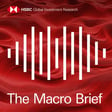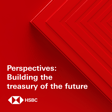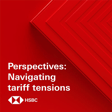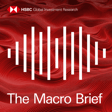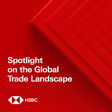Become a Creator today!Start creating today - Share your story with the world!
Start for free
00:00:00
00:00:01

A global update, Just-in-Time's travails, and the EU builds back - HSBC Global Research
Janet Henry assesses the pace of economic recovery and the risks, including inflation. Shanella Rajanayagam looks at disruptions to Just-in-time supply chains, plus an EU COVID-19 and funding update from Chris Hare. Disclaimer
To stay connected and to access free to view reports and videos from HSBC Global Research click here
Hosted on Acast. See acast.com/privacy for more information.
Transcript
Introduction to HSBC Global Viewpoint
00:00:00
Speaker
This is HSBC Global Viewpoint, your window into the thinking, trends and issues shaping global banking and markets.
00:00:09
Speaker
Join us as we hear from industry leaders and HSBC experts on the latest insights and opportunities for your business.
00:00:18
Speaker
A heads up to our listeners that this episode has been recorded remotely, therefore the sound quality may vary.
00:00:24
Speaker
Thank you for listening.
Macro Viewpoint Segment Overview
00:00:33
Speaker
Hello and welcome to the Macro Viewpoint.
00:00:36
Speaker
This is our weekly rendezvous with the economists and strategists here at HSBC Global Research for their take on some of the top macroeconomic issues on the global agenda.
00:00:46
Speaker
This week, it's all about growth and inflation.
00:00:48
Speaker
In a moment,
Economic Forecasts and Global Risks
00:00:49
Speaker
we'll be speaking with our global chief economist, Janet Henry, about her team's latest forecasts and a number of risks.
00:00:56
Speaker
We're also chatting with Shanela Rajanayagam.
00:00:58
Speaker
Shanela is our trade economist and she has been looking at supply disruptions and the impact of the so-called just-in-time manufacturing processes.
00:01:06
Speaker
And we'll take a slightly deeper dive into Europe with economist Chris Hare.
00:01:10
Speaker
We'll be asking Chris about the latest developments in the fight against COVID-19 and whether the EU can build back better under its 750 billion euro next generation EU recovery fund and other initiatives.
00:01:27
Speaker
This podcast was recorded for publication on the 24th of June.
00:01:30
Speaker
All our disclosures and disclaimers associated with this edition of the Macro Viewpoint must be viewed on the link attached to the media player.
00:01:38
Speaker
Our economics team, led by Janet Henry, has just published its latest quarterly, and Janet joins us now.
00:01:44
Speaker
So, Janet, the global economy is doing much better than expected a year ago.
00:01:48
Speaker
What are you now forecasting in terms of growth for this year and next?
00:01:52
Speaker
Well, we've actually just revised up our global GDP forecast for 2021, and some of that carries over into 2022, where we've also made a marginal upgrade.
00:02:03
Speaker
But as is often the case, there are a lot of moving parts within that.
00:02:06
Speaker
Broadly speaking, the
00:02:08
Speaker
biggest upgrades have come through in the advanced economies where the vaccination rollouts have been coming through and policy is still very supportive.
00:02:16
Speaker
Our emerging market aggregate is actually broadly unchanged.
00:02:20
Speaker
But a lot of that is just because it's being held back by India in 2021.
00:02:25
Speaker
We've actually made some upward revisions across CMEA and Latin America as part of this forecasting round.
00:02:33
Speaker
Now, just as growth
Inflation Concerns and Central Bank Responses
00:02:34
Speaker
is lurching higher, so too is inflation.
00:02:36
Speaker
How concerned are you about that?
00:02:39
Speaker
Well, inflation has jumped quite significantly.
00:02:42
Speaker
Obviously, what we've seen since the lows of the pandemic last March or April is some really big increases in commodity prices, and that is impacting everywhere.
00:02:52
Speaker
So a lot of countries in the world are now running above central bank objectives or targets.
00:02:59
Speaker
But other countries have also seen some kind of bottleneck effects as they're starting to reopen and demand is resurging much more quickly than the supply side.
00:03:09
Speaker
And now we're starting to see it not just in terms of goods prices, but in areas of service sector demand where that is starting to rotate towards those kind of areas.
00:03:20
Speaker
It should be, I suppose, transitory.
00:03:23
Speaker
We should, over the course of the next year, see inflation come back down.
00:03:28
Speaker
But as with the growth outlook, there are a lot of inflation risks out there as well.
00:03:34
Speaker
So you mentioned central banks there.
00:03:36
Speaker
How do you expect central banks to respond to this?
00:03:39
Speaker
Well, currently, central banks are responding in a number of different ways, which is obviously a step change from what happened at the start of the pandemic when everyone was turning the liquidity taps on.
00:03:50
Speaker
We've already seen the likes of Russia and Brazil raise interest rates quite significantly in the emerging world.
00:03:57
Speaker
And across the advanced economies, some have already started to taper their asset purchases.
00:04:03
Speaker
But we've got a number of important G10 central banks
00:04:06
Speaker
where they are absolutely on the sidelines and still being much more patient about starting to adjust away from this extreme policy and response that they delivered at the start of the pandemic.
00:04:18
Speaker
And
Interest Rate Policies of Central Banks
00:04:19
Speaker
do you expect in terms of what happens next, is everyone going to follow the Fed's lead?
00:04:24
Speaker
No, we actually think some central banks will lead the Fed.
00:04:27
Speaker
Obviously, the Fed has got a different policy willing to overshoot 2% inflation moderately for a period.
00:04:34
Speaker
They also want to wait until the economy is back at maximum employment.
00:04:38
Speaker
So, yes, we think the Fed is going to slow its pace of asset purchases starting in December of this year, but we're not looking for rate increases until 2023.
00:04:47
Speaker
But a number of the G10 economies, we think, will be raising interest rates before that.
00:04:53
Speaker
Norges Bank this year, but next year, New Zealand, Canada, and probably most notably the Bank of England, where we're now forecasting 40 basis points of increases in 2022.
00:05:03
Speaker
The Fed chairman himself has said that the sort of no template really is for exiting a pandemic.
00:05:10
Speaker
So there are loads of uncertainties, aren't there?
00:05:13
Speaker
Absolutely.
Economic Outlook Uncertainties
00:05:14
Speaker
There are still lots of uncertainties, both on the growth and the inflation side.
00:05:18
Speaker
And on growth, yes, COVID itself is still the biggest downside risk.
00:05:22
Speaker
The biggest upside risk is still this huge stock of savings that's been accumulated by households over the last year.
00:05:30
Speaker
If that's drawn down more quickly, we could see a bigger consumer rebound and more upper pressure on inflation.
00:05:36
Speaker
But there are also other uncertainties.
00:05:39
Speaker
The huge scale of fiscal stimulus is already starting to expire in a number of emerging economies.
00:05:45
Speaker
It's going to wane in the US and to a lesser extent in Europe later this year and going into 2022.
00:05:51
Speaker
So that could certainly lead to a slowdown in activity in a number of places.
00:05:56
Speaker
And there's still a lot of uncertainties related to the rotation from goods to services and what happens regarding investment spending and capital goods demand and what that means for trade and for commodity prices.
00:06:07
Speaker
and a big uncertainty related to labour markets.
00:06:10
Speaker
We keep hearing about the labour shortages that are in place in a number of sectors and a number of countries, how much that is just linked to these job support schemes might workers' return, or indeed might we just see a bigger increase in wage growth and, again, get back to growing concerns about inflation.
00:06:30
Speaker
A lot of uncertainty.
00:06:32
Speaker
Janet, that's a great summary.
00:06:33
Speaker
Thank you very much for your time today.
00:06:35
Speaker
Thank you, Chris.
00:06:37
Speaker
Janet Henry, our global chief economist.
Trade Disruptions and Manufacturing Challenges
00:06:41
Speaker
Supply chain disruptions are the subject for our next guest.
00:06:44
Speaker
Trade economist, Shanela Rajanagam, this week published a report looking at the extent of the disruptions and the long running strategy of just in time supply chain management for many of the world's manufacturers.
00:06:56
Speaker
So Shanela, can you give us an idea of some of these trade disruptions that are occurring at the moment?
00:07:02
Speaker
Sure, Piers.
00:07:02
Speaker
So over the past year, there has been a lot of trade disruption due to ongoing shipping disruption, but also really strong demand for certain products like electronics, autos, and even construction materials.
00:07:15
Speaker
And as a result of this, the lead times for certain components and final goods have lengthened, plus input prices continue to surge.
00:07:25
Speaker
So for instance, in the US, there's evidence that this disruption is lingering.
00:07:31
Speaker
For example, electrical components have remained in short supply for eight consecutive months.
00:07:38
Speaker
Also, there have been shortages of semiconductors and steel for around six consecutive months, as well as shortages of foreign products.
00:07:47
Speaker
So in your report, you talk about just-in-time manufacturing.
00:07:51
Speaker
So firstly, remind us what that is and why it is such a significant factor in these disruptions.
00:07:59
Speaker
Sure.
00:07:59
Speaker
So just-in-time manufacturing was pioneered by Toyota over 60 years ago, and it essentially aims to cut down on excess inventory.
00:08:08
Speaker
So under this process, producers will only order and hold the amount of passing components they actually need.
00:08:16
Speaker
However, that of course relies on the seamless movement of these components between buyers and sellers around the world.
00:08:22
Speaker
And COVID-19, due to those disruptions that I mentioned earlier, has significantly affected just-in-time and lean manufacturing processes.
00:08:33
Speaker
So are we going to actually change from just-in-time to just-in-case?
00:08:39
Speaker
Well, that is the question.
00:08:40
Speaker
And certainly the effectiveness of just-in-time manufacturing has been questioned during COVID.
00:08:49
Speaker
And it has prompted some companies to look to hold higher stocks of components going forward.
00:08:55
Speaker
So for instance, there's evidence to suggest that HP companies
00:08:58
Speaker
is stockpiling critical computer parts, a Taiwan semiconductor manufacturing company.
00:09:04
Speaker
They expect their customers to gradually prepare higher levels of inventory going forward.
00:09:10
Speaker
And even Toyota, the pioneer of just-in-time manufacturing, they have been stockpiling critical components, which has essentially enabled it to better mitigate the chip shortage compared to some of its competitors.
00:09:22
Speaker
However, overall, I don't think this is the end of just-in-time manufacturing.
00:09:26
Speaker
Holding excess stocks can be quite costly for businesses.
00:09:30
Speaker
And of course, there's a risk that they could be left with excess supply once demand eventually normalizes as lockdown restrictions lift.
00:09:39
Speaker
So are there any
Stockpiling and Trade Flow Impacts
00:09:40
Speaker
implications to your trade forecast from this short-term stockpiling?
00:09:44
Speaker
Well, building up these safety stocks or holding excess inventories could help to support trade flows going forward.
00:09:51
Speaker
The risk, of course, is that it can exacerbate existing shortages of critical components.
00:09:57
Speaker
Now, we might expect businesses to build up stocks of goods, particularly where production tends to be concentrated in a small number of economies.
00:10:05
Speaker
or for products that are in high demand.
00:10:08
Speaker
So with ongoing shipping disruptions that last at least until the end of this year, we could see some build up in stocks of electronics and autos components, but also that trade could remain disrupted for some time to come.
00:10:21
Speaker
And if we look longer term, what sort of alternative measures could businesses take to guard against future trade shocks?
00:10:29
Speaker
Sure, so there
Business Strategies for Future Trade Shocks
00:10:30
Speaker
are various other measures businesses could take aside from building up stocks.
00:10:35
Speaker
They could look to diversify markets and trade deals are a good way of doing this.
00:10:40
Speaker
They could also look to bring sourcing closer to home, so either nearshoring or reshoring.
00:10:45
Speaker
They could also look to bring some production in-house, so the likes of vertical integration.
00:10:50
Speaker
And they may also use digital technologies to better monitor their supply chains and to better manage inventories.
00:10:58
Speaker
Janela, thank you very much.
00:10:59
Speaker
Thanks, Piers.
00:11:01
Speaker
Here in
Europe's Pandemic Recovery and Delta Variant Impact
00:11:02
Speaker
Europe, economist Chris Hare has just published our team's weekly COVID-19 tracker.
00:11:07
Speaker
Chris joins us now to talk about the latest situation.
00:11:09
Speaker
So, Chris, to what extent are things improving on the pandemic front?
00:11:13
Speaker
Well, at first blush, things on the European continent do seem to be getting better.
00:11:17
Speaker
We're seeing falls in case numbers.
00:11:20
Speaker
We're seeing a vaccine rollout that is progressing pretty quickly and governments are able to continue loosening some restriction measures.
00:11:29
Speaker
There is a bit of a concern though and that's the rising risk of the more transmissible delta variant of the disease which has certainly taken a hold in the UK where cases are rising, it's also taken a hold in Portugal and the European Centre for Disease Control now predicts that the delta variant could take up around 90% of cases across Europe as a whole by the end of August.
00:11:53
Speaker
Now, that could be a concern to the extent to which it could lift cases.
00:11:56
Speaker
And I think there are questions still about whether that will start causing risks around further reopening over the coming months.
00:12:04
Speaker
Where we do take heart is from the fact that in the UK, where we are seeing rising case numbers, we're not seeing an increase in hospitalisations and we're not seeing a very high likelihood of a reversal of the easing in measures that we've seen so far.
00:12:18
Speaker
But certainly this Delta variant, I think, is something to watch very closely.
00:12:23
Speaker
Now, you've also been
Policy Options for Growth and Transition in Europe
00:12:24
Speaker
looking at some of the longer term prospects for economic recovery and how policymakers are aiming to build back better.
00:12:31
Speaker
What have you found?
00:12:33
Speaker
Yes, we look at various sorts of policy options for European policymakers to try to lift rates of long run growth and also to try to facilitate the green and digital transitions.
00:12:45
Speaker
And within that, we look at four different policy areas.
00:12:47
Speaker
First, we look at the kind of measures that have been put in place to try to prevent supply side scarring from COVID-19.
00:12:54
Speaker
The news here so far has been pretty good given job support schemes.
00:12:58
Speaker
Long term unemployment doesn't look like it's set to rise in the way that we have feared before the pandemic.
00:13:04
Speaker
Second policy areas on investment, and this perhaps is the most important.
00:13:07
Speaker
We're set to see some pretty hefty increases in public investment and incentives to try to boost private investment, all part of the 750 billion euro
00:13:18
Speaker
Next Generation EU Fund and that could in principle lift investment rates to not only above pre-COVID levels but above pre-2008 levels.
00:13:28
Speaker
Third we look at industrial strategy where a lot of measures here are geared towards small and medium businesses particularly with regards to try to facilitate that transition towards a greener more digital economy.
00:13:40
Speaker
And fourth, we look at structural reforms, which is sort of a mixed bag in terms of the outlook in our view.
00:13:45
Speaker
Nothing major on the labour market, but bits and pieces that could be fairly important when countries are looking at trying to improve public administration and their legal systems, for example.
00:13:54
Speaker
There is quite a lot on the supply side policy agenda.
00:13:58
Speaker
And will the combined effect of all this be to lift growth, do you think?
00:14:03
Speaker
Well, yes, taking
Eurozone Growth Trends and Investment
00:14:04
Speaker
all that together, as I said, it's a bit of a mixed bag, I think, with the supply side policy outlook.
00:14:09
Speaker
But taking things into context, by our estimates, we think that long run growth in the eurozone probably trended at around 1% per year in the decade leading up to COVID-19.
00:14:21
Speaker
But you take all these policies together and in particular the prospect of significantly higher levels of investment, we actually think long-run growth trends can lift a little bit over the coming decade, perhaps up to around one and a quarter percent per year.
00:14:36
Speaker
So it's a little bit of an improvement.
00:14:37
Speaker
So you could conclude that Europe may have a chance of building back a little bit better after the pandemic.
00:14:44
Speaker
Chris, thanks very much for taking us through all that.
00:14:47
Speaker
Thank you.
00:14:48
Speaker
So
Closing Remarks and Information Access
00:14:49
Speaker
that's the end of the Macro Viewpoint podcast for this week.
00:14:52
Speaker
Special thanks again to Janet Henry, Shanela Rajanayagam and Chris Hare.
00:14:57
Speaker
Thanks for listening.
00:14:58
Speaker
We'll be back next week.
00:15:06
Speaker
Thank you for listening today.
00:15:08
Speaker
This has been HSBC Global Viewpoint Banking and Markets.
00:15:12
Speaker
For more information about anything you heard in this podcast or to learn about HSBC's global services and offerings, please visit gbm.hsbc.com.
